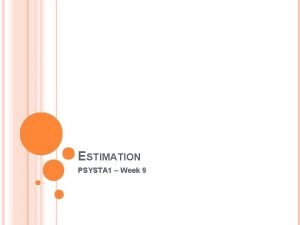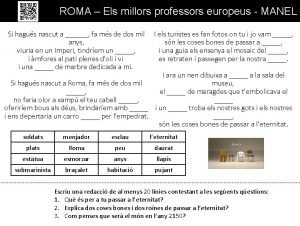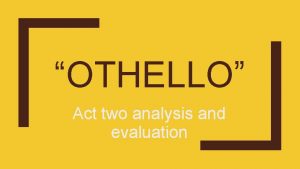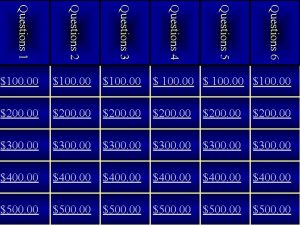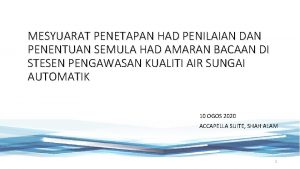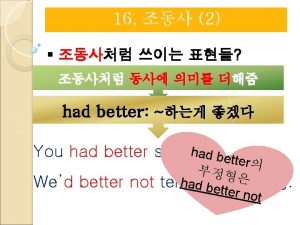Questions I have had some professors who have




















- Slides: 20

Questions • I have had some professors who have a preference on APA style, is the library website a good source for APA format? Do you have a particular preference? • What are the consequences if a researcher does not behave ethically towards individuals? • How do you determine the sample size in a given research study? • How do you know whether or not the chosen sample is representative of the target population?

More Questions • How do you know if you are inflicting any psychological harm on subjects in animal research? (such as in a controlled lab experiment and not just in observation). • In the abstract of a research report, do you need to separate the sections into background, methods, results, conclusions or can you make it one paragraph? • If a research has to ethically release all information to a participant before an experiment, how can you ethically run a double blind study where the participant has no idea what is being done.

More Questions • How can the way in which results are reported become an ‘ethical issue’ of the research process? • To do a research, you have to take the Ethics code test. Do you have to retake the test for every research study/experiment that you do or do you only have to take it once?

Research strategies and validity Chapter 6 Dusana Rybarova Psyc 290 B May 22 2006

Outline 1. Introduction to research strategies 2. Validity and its threats - internal validity - external validity 3. Research strategies, research designs and research procedures

1. Introduction to research strategies • research strategy – reflects the general approach and goals of a research study • types of research strategies – descriptive strategy – Nonexperimental strategy – correlational strategy – experimental strategy – quasi-experimental strategy

1. Introduction to research strategies • Descriptive strategy – the goal is to describe the state of affairs at the time of the study – measures variables as they exist naturally – e. g. 19% of eligible voters participated in the election • Correlational strategy – measures two variables, usually as they exist naturally – the goal of this strategy is to describe a relationship between the two variables without attempting to explain the cause of the relationship – e. g. Are students GPA’s related to their parent’s income? • Nonexperimental strategy – Answers questions about the relationship between two variables by demonstrating a difference between two groups or two threatment conditions – E. g. verbal scores of 6 -years old boy and 6 -years old girls

1. Introduction to research strategies • Experimental strategy – the researcher manipulates one variable (called independent variable) while observing or measuring a second variable (dependent variable) – this is the ‘true’ experiment because independent variable is manipulated by the researcher (e. g. room temperature) – the goal of experimental strategy is to determine whether a causal relationship exists between two variables

1. Introduction to research strategies • Quasi-experimental strategy – uses a nonmanipulated variable to define groups or conditions (e. g. time or age) or pre and post threatment – controls other variables as much as possible – the goal is to obtain evidence in support of a cause-and-effect relationship – however, a quasi-experimental strategy can not unambiguously establish a causal relationship

2. Validity and its threats • validity is the standard criterion by which researchers judge the quality of research • in this case the concept of validity applies to an entire research study • any component of a research study that introduces questions or raises doubts about the quality of the research process or the accuracy of the research results is a threat to validity

2. Validity and its threats • Internal validity – is concerned with factors within the research study that raise doubts about the results or the interpretation – any factor within the study that allows an alternative explanation for the results is a threat to internal validity – e. g. example with room temperature and performance

2. Validity and its threats • threats to internal validity – Extraneous variables • any variable in a research study other than the two variables being studied (both systematic and unsystematic) – unsystematically changing variables are usually not a problem • confounding variable is an extraneous variable that is allowed to change systematically along with the two variables being studied (e. g. time of the day in the temperature-performance study)

2. Validity and its threats • threats to internal validity – sources of extraneous/confounding variables • participant variables – assignment bias – when the process used to assign different participants to different threatments produces groups of individuals with noticeably different characteristics (e. g. one group is smarter, more motivated) • environmental variables – size of room, time of day, or gender of the experimenter • measurement variables – practice effects – prior exposure to a measurement procedure provides participants with additional skills that produce improved scores (e. g. the same exam) – fatigue – prior participation tires the participants so that their scores on subsequent measurements are lower

2. Validity and its threats • External validity – concerns the extent to which the results obtained in a research study hold true outside the constraints of the study – Can the results be generalized to other populations, other settings, other measurements? – e. g. can we generalize results from a wellcontrolled laboratory situation to the uncontrolled chaos of the real world?

2. Validity and its threats • threats to external validity – Participants • characteristics unique to a specific group of participants in a study may limit ability to generalize the results to individuals with different characteristics – e. g. college students, volunteer bias, cross-species generalizations – Features of the study • characteristics unique to the specific procedures used in a study may limit ability to generalize the results to situations where other procedures are used – e. g. novelty effect, reactivity, specifics of the study (masking experiments, lexical decisions)

2. Validity and its threats • threats to external validity – experimenters • characteristics unique to the specific experimenter conducting the study may limit ability to generalize the results to situations with a different experimenter – e. g. experimenter bias, experimenter characteristics – measurements • characteristics unique to the specific measurement procedure may limit ability to generalize the results to situations where a different measurement procedure is used – e. g. sensitization (the impact of being assessed), generality across different measures (heart beat vs. questionnaire), time of measurement

2. Validity and its threats • Balancing internal and external validity – attempts to increase internal validity can reduce external validity (laboratory experiments) – research that attempts to gain a high level of external validity will often create a research environment that closely resembles the outside world – there tends to be a tradeoff between internal and external validity (if you increase internal validity, external validity decreases a vice versa)

2. Validity and its threats • Validity of individual research strategies – descriptive strategy • high external validity • low internal validity – Nonexperimental strategy • High external validity • Low internal validity – correlational strategy • high external validity • low internal validity

2. Validity and its threats • Validity of individual research strategies – experimental strategy • high internal validity • low external validity – quasi-experimental strategy • higher internal validity than descriptive and correlational studies • lower internal validity than true experiments • relatively high external validity

3. Research strategies, research designs, and research procedures • Research strategy – refers to the general approach and goals of the study • Research design – general plan for implementing a research strategy (e. g. group versus individual, same individuals vs. different individuals, number of variables included) • Research procedure – an exact, step-by-step description of a specific research study (exact involvement of individuals, measurement of variables etc. )
 Hierarchy of professors
Hierarchy of professors Champion of filipino students ilipino students
Champion of filipino students ilipino students Average iq of university professors
Average iq of university professors Manel els millors professors europeus
Manel els millors professors europeus Foreign professors
Foreign professors I ate my breakfast
I ate my breakfast I have breakfast before i went to school
I have breakfast before i went to school Betty butter tongue twister
Betty butter tongue twister Tongue twister butter bitter
Tongue twister butter bitter They say it only takes a little faith
They say it only takes a little faith They say sometimes you win some
They say sometimes you win some Cake countable or uncountable noun
Cake countable or uncountable noun What is contact force
What is contact force Some say the world will end in fire some say in ice
Some say the world will end in fire some say in ice Some say the world will end in fire some say in ice
Some say the world will end in fire some say in ice Some may trust in horses
Some may trust in horses Shapes that have 6 faces and 12 edges
Shapes that have 6 faces and 12 edges Sparknotes othello act 2
Sparknotes othello act 2 If you had studied hard, you wouldn't failed the exam.
If you had studied hard, you wouldn't failed the exam. Conditional 3
Conditional 3 Have you ever had the feeling
Have you ever had the feeling


